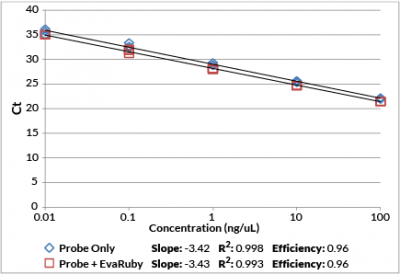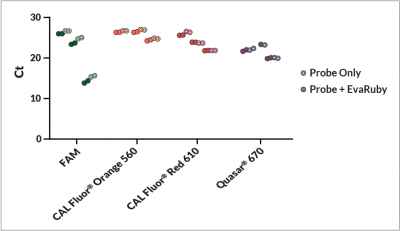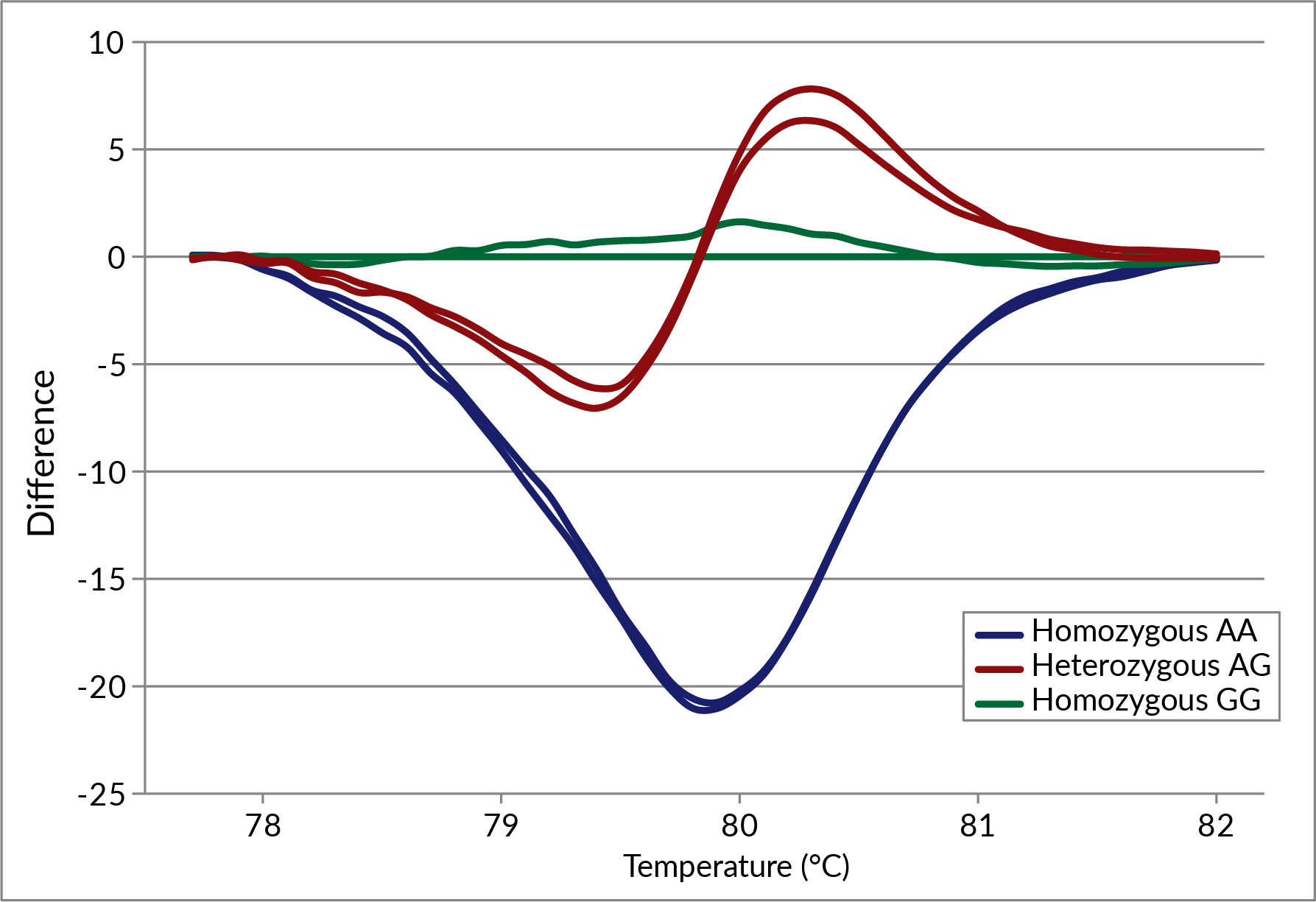Content #1
Content #1
Content #1
Visible red fluorescent DNA-binding dye for qPCR, HRM®, and LAMP. Can be combined with probe-based qPCR reactions with little cross-talk in other channels.
EvaRuby™ is the first visible red DNA-binding dye for both qPCR and HRM. The dye has unique spectral properties that minimize cross-talk between channels. EvaRuby™ can be used as a typical intercalating dye for qPCR, HRM®, and LAMP. The dye also can be incorporated into probe-based qPCR assays to monitor the reaction in real-time and perform post-qPCR high-resolution melt analysis.
EvaRuby™ is a visible red fluorescent nucleic acid dye designed for qPCR, as such it is essentially non-fluorescent by itself, but becomes fluorescent upon binding to dsDNA. Unlike EvaGreen® or SYBR® intercalating qPCR dyes, EvaRuby™ has a long Stokes shift and orange fluorescent emission. With excitation/emission peaks at 480/613 nm, EvaRuby™ Dye is excited using the same green/blue channel as EvaGreen® but is detected in the orange (JUN™ or ROX) channel. As a result, EvaRuby™ has minimal cross-talk in other detection channels and therefore can be incorporated into singleplex and multiplex probe-based qPCR assays (Figure 1).

Figure 1. The effect of 1X EvaRuby™ Dye on the amplification and detection of the TFCR gene by a CAL Fluor® Red 610 hydrolysis probe in 10-fold dilutions of Human gDNA. Both EvaRuby™ and the CAL Fluor® Red 610 probe share the 610 nm emission channel. However, since EvaRuby™ is minimally excited by the Qiagen Rotor-Gene® Q Orange (585 nm) excitation channel used for the probe, the standard curve generated by the probe is practically unchanged by the presence of EvaRuby™.
While EvaRuby™ can be used as a traditional intercalating qPCR dye to perform real-time qPCR, melt curve analysis, LAMP, and HRM®, the dye’s main advantage is that it can be incorporated into probe-based qPCR assays. Unlike other intercalating dyes, EvaRuby’s™ unique spectral properties allow it to be combined with commonly used fluorescent qPCR probes with little cross-talk in other fluorescence channels. The dye can be added to the reaction mix during reaction setup without affecting probe specificity (Figures 1, 2) while expanding the capabilities of probe-based qPCR to include real-time troubleshooting and post-qPCR high-resolution melt analysis (Figure 3). Note that for traditional single-color dye-based qPCR, we still recommend using EvaGreen® Dye.

Figure 2. The effect of EvaRuby™ on Ct determination by hydrolysis probes. Three independent qPCR assays were performed for each probe dye using common probe-based qPCR settings. Each point is the Ct value determined by the indicated probe. Despite some overlap in the excitation or emission spectra, the Ct values obtained by the probes in a standard probe-based assay without EvaRuby™ (rings) are minimally different from the Ct values obtained when probes are used in combination with EvaRuby™ (circles).

Figure 3. High Resolution Melt Data Difference Plot. EvaRuby™ Dye at 1X in Forget-Me-Not™ Universal Probe qPCR Master Mix (Cat. No. 31043) was used to detect the Applied Biosystems® MeltDoctor™ HRM Positive Control Kit. Data was acquired using the Qiagen® Rotor-Gene® Q, 0.1°C/2 sec, with a 470 nm excitation and 610 nm emission filter. Data analysis was performed with uAnalyzeSM (https://dna-utah.org) using baseline subtraction. EvaRuby™ Dye can clearly distinguish each homozygous variant as well as the heterozygous variant.
Dye-based qPCR has low target specificity but has the advantage of performing a rapid and facile confirmation of results with melt curve analysis. On the other hand, probe-based qPCR benefits from high target specificity but is not compatible with melt curve analysis. Instead, confirmation of the qPCR results is often done by gel electrophoresis, a labor-intensive step that increases the time to results. Using EvaRuby™ in combination with probe-based qPCR enables the use of probe for high target specificity together with an intercalating dye for melt analysis and confirmation of results. Furthermore, because EvaRuby™ signal is independent from probe signal, it acts as an internal control for PCR amplification. For example, despite successful amplification, a degraded or suboptimal probe may fail to bind to the amplified target sequence and as a result, qPCR would incorrectly report amplification failure. However, with EvaRuby™ present, amplification would still be detected during qPCR and can be identified with melt curve analysis.
EvaRuby™ requires detection using a custom qPCR detection channel. Your qPCR instrument must have ~470 nm excitation and ~610 nm emission filters, as well as the option to acquire data using this non-standard filter combination. Instruments with paired excitation/emission filters may not be compatible with the dye. EvaRuby™ has been validated on Applied Biosystems® QuantStudio™ 5 96-well and Qiagen® Rotor-Gene® Q instruments. A compatibility table for other instruments is available in the PI; however it is important to confirm compatibility by checking your instrument technical specifications or by contacting the instrument manufacturer before purchasing EvaRuby™ Dye.
If your qPCR instrument requires a passive reference dye, use VeriFluor™ Far-Red (Cat. no. 29087) for optimal results. VeriFluor™ Far-Red is detected in the red (Cy®5 or Mustang Purple™) fluorescence channel. High ROX concentrations (~500 nM) are incompatible with EvaRuby™. Using low ROX concentrations (~50 nM) for normalization is suboptimal and will result in a small increase of the background fluorescence in the EvaRuby™ channel.
Bioscience kits
The guaranteed shelf life from date of receipt for bioscience kits is listed on the product information sheet. Some kits have an expiration date printed on the kit box label, this is the guaranteed shelf life date calculated from the day that the product shipped from our facility. Kits often are functional for significantly longer than the guaranteed shelf life. If you have an older kit in storage that you wish to use, we recommend performing a small scale positive control experiment to confirm that the kit still works for your application before processing a large number of samples or precious samples.
Antibodies and other conjugates
The guaranteed shelf life from date of receipt for antibodies and conjugates is listed on the product information sheet. Antibodies and other conjugates often are functional for significantly longer than the guaranteed shelf life. If you have an older conjugate in storage that you wish to use, we recommend performing a small scale positive control experiment to confirm that the product still works for your application before processing a large number of samples or precious samples.
For lyophilized antibodies, we recommend reconstituting the antibody with glycerol and antimicrobial preservative like sodium azide for the longest shelf life (note that sodium azide is not compatible with HRP-conjugates).
Chemicals, dyes, and gel stains
Biotium guarantees the stability of chemicals, dyes, and gel stains for at least a year from the date you receive the product. However, the majority of these products are highly stable for many years, as long as they are stored as recommended. Storage conditions can be found on the product information sheet or product safety and data sheet, material safety data sheet, and on the product label. Fluorescent compounds should be protected from light for long term storage.
If you have a Biotium compound that has been in storage for longer than one year that you wish to use, we recommend performing a small scale positive control experiment to confirm that the compound still works for your application before processing a large number of samples or precious samples.
Expiration date based on date of manufacture (DOM)
If your institution requires you to document expiration date based on date of manufacture for reagents, please contact techsupport@biotium.com for assistance.
Chemical products with special stability considerations:
Esters
Ester compounds include the following:
Ester dyes are stable in solid form as long as they are protected from light and moisture. Esters are not stable in aqueous solution. Concentrated stock solutions should be prepared in anhydrous DMSO (see Biotium catalog no. 90082). Stock solutions in anhydrous DMSO can be stored desiccated at -20°C for one month or longer. Esters should be diluted in aqueous solution immediately before use. Succinimidyl esters (SE) should be dissolved in a solution that is free of amine-containing compounds like Tris, glycine, or protein, which will react with the SE functional group. AM esters and diacetate compounds should be dissolved in a solution that is free of serum, because serum could contain esterases that would hydrolyze the compound.
A note on CF® Dye succinimidyl ester stability
Succinimidyl esters (SE) are generally susceptible to hydrolysis, which can result in lower labeling efficiency. Many commercially available fluorescent dyes used for life science research are heavily sulfonated dyes which makes them particularly hygroscopic, worsening the hydrolysis problem. In addition, for several commercially available SE reactive dyes, the SE group is derived from an aromatic carboxylic acid, while the SE group in all of Biotium’s CF® Dyes is prepared from an aliphatic carboxylic acid. This structural difference reduces the susceptibility of CF® Dye SE reactive groups to hydrolysis, resulting in relatively stable reactive dyes with consistently higher labeling efficiency compared to other SE derivatives of other fluorescent dyes.
Maleimides, MTS and thiosulfate dyes
Like the succinimidyl ester dyes, these dyes are also susceptible to hydrolysis, although generally to a much lower degree. Thus, for long term storage, anhydrous DMSO is recommended for making stock solutions.
Other reactive dyes
Amines, aminooxy (also known as oxylamine), hydrazide, azide, alkyne, BCN, and tyramide reactive dyes, as well as dye free acids, are generally stable in aqueous solution when stored at -20°C for 6-12 months or longer, as long as no compounds are present that may react with the dye’s functional group. See the product information sheets for specific reactive dyes more information.
Coelenterazines and D-luciferin
Coelenterazines are stable in solid form when stored as recommended; they are not stable in aqueous solution. Concentrated coelenterazine stock solutions (typically 1-100 mg/mL) should be prepared in ethanol or methanol; do not use DMSO or DMF to dissolve coelenterazines, because these solvents will oxidize the compounds. Ethanol or methanol stocks of coelenterazine can be stored at -20°C or below for six months or longer; alcohol stocks may evaporate during storage, so use tightly sealing screw cap vials and wrap the vials with Parafilm for long term storage. Propylene glycol also can be used as a solvent to minimize evaporation. If the solvent evaporates, the coelenterazine will still be present in the vial, so note the volume in the vial prior to storage so that you can adjust the solvent volume to correct for evaporation if needed. Prepare working solutions in aqueous buffers immediately before use. Coelenterazines are stable for up to five hours in aqueous solution.
Aquaphile™ coelenterazines are water soluble formulations of coelenterazines. They are stable in solid form when stored as recommended. Aquaphile™ coelenterazines should be dissolved in aqueous solution immediately before use. They are stable for up to five hours in aqueous solution.
Note that coelenterazines are predominantly yellow solids, but may contain dark red or brown flecks. This does not affect product stability or performance. If your coelenterazine is uniformly brown, then it is oxidized and needs to be replaced.
D-luciferin is stable in solid form and as a concentrated stock solution when stored as recommended; it is not stable at dilute working concentrations in aqueous solution. Prepare concentrated D-luciferin stock solutions (typically 1-100 mg/mL) in water, and store in aliquots at -20°C or below for six months or longer. Prepare working solutions immediately before use.
For dyes or reagents that are supplied lyophilized (as solids), it is hard to compare quantities based on appearance of the dye in the tube, because during the lyophilization process the dye can dry down in different ways, either spread out all over the tube, clumped together, or coating the sides or bottom of the tube. Centrifugation of the tube may not help in collecting the dye solid to the bottom of the tube as this generally works for solutions. However, lyophilized solids are packaged based on highly accurate absorbance measurement of the reagent solution prior to drying, so the vial will contain the correct amount of dye.
Biotium ships all antibodies (primary, secondary and conjugates) at room temperature. We guarantee their quality and performance under these conditions based upon our stability testing. Antibodies were subjected to accelerated stability testing by storing them at various temperatures (4°C, room temperature, or 37°C) for 1 week to mimic simulated shipping conditions and tested in immunostaining experiments. All antibodies showed the expected brightness and specificity, even after storage at sub-optimal temperatures for a week or longer. You can also download our Product Storage Statement here.
In line with our goal to be more environmentally friendly by reducing the use of excess packaging, and lowering shipping costs for our customers, products that have passed our stability testing are shipped at room temperature.
Once you have received the antibody vial, please follow the long-term storage instructions on the product information (PI) sheet.